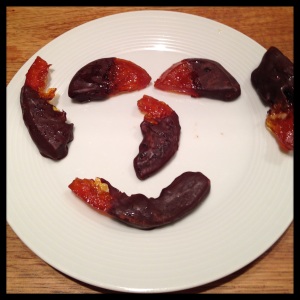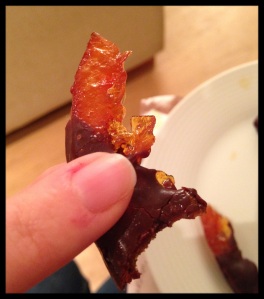The materials submitted to the Journal of Epicurea by Levy et al. aim to provide evidence for the quality, reproducibility and longevity of Orangettes (OGT) produced by the Levy Method.
While both single and two-phase OGT methods have been reported previously, the authors of the present study undertook a two-phase OGT synthesis, the product of which is shown in Figure 1. The three key parameters responsible for triggering an Ingestion Response were all rated excellent, scoring > 90 % [Visual appeal: 92 %, Olfactory resonance: 98.5 % & Gustatory induction: 94 %]. This feat could be attributed to the high quality starting materials and/or expertise of preparation, shown HERE and HERE. It is certainly commendable that the OGTs withstood the Royal Mail agitation test, arriving at the review laboratory with few signs of mechanical stress.

Figure 3: Self-assembly of Levy Method OGTs. Assembly defect evident on the far right of the field of view.
The OGTs produced by this method also show considerable potential to study interfacial dynamics (see Figure 2). Furthermore, their apparent ability to self-assemble (Figure 3) could be a result of non-uniform aspect ratios. This observation is both unexpected and may be of great interest, particularly to the Parental community. Possible evidence of defects in the self-assembly, perhaps as a result of a degree of inherent heterogeneity, may be observed to the far right of the field of view in Figure 3 and also warrant further investigation.
Overall the quality of the materials produced by the Levy OGT Method are impressive. While the in-batch reproducibility is promising, further samples are encouraged in order that the reproducibility be more fully assessed. In fact, this reviewer believes it would be in the interest of the wider Epicurean community that the Levy OGT Method be published in full in order for these findings to be thoroughly investigated in other laboratories.
While the “Levy Method” will be of considerable interest to the Chocolate Orange community, and in particular those with an interest in Orangette Synthesis, it is the opinion of this reviewer that the world-class quality of these materials would be of sufficient interest to the wider Epicurean community to warrant publication in the Journal of Epicurea.
Supplementary technical notes:
- Whilst psuedo-solid phase methods of ingestion may be employed, this reviewer recommends the use of a 1 % (w/v) solution of EBT* (Figure S1).
- Ingestion of 1 unit of OGT may be attempted but researchers should be aware of the risk of triggering a cascade reaction resulting in momentary over-consumption. The risks of long term exposure are yet to be established, this researcher can vouch for the acute uptake of up to 6 OGT units.
* English Breakfast Tea
The reviewer thanks Dr. Levy for the submission of this high quality material for review. It was very, very tasty!


